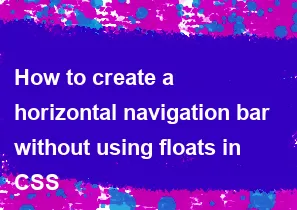How to create a horizontal navigation bar without using floats in CSS

Creating a horizontal navigation bar without using floats in CSS is possible and often preferred for cleaner and more modern layouts. One popular approach is to use flexbox. Here's an example of how you can create a horizontal navigation bar using flexbox:
html<!DOCTYPE html>
<html lang="en">
<head>
<meta charset="UTF-8">
<meta name="viewport" content="width=device-width, initial-scale=1.0">
<title>Horizontal Navigation Bar</title>
<style>
body {
margin: 0;
padding: 0;
font-family: Arial, sans-serif;
}
header {
background-color: #333;
color: #fff;
padding: 10px;
}
nav {
display: flex;
justify-content: space-around;
background-color: #444;
padding: 10px 0;
}
nav a {
color: #fff;
text-decoration: none;
padding: 10px 20px;
transition: background-color 0.3s ease;
}
nav a:hover {
background-color: #555;
}
</style>
</head>
<body>
<header>
<h1>My Website</h1>
</header>
<nav>
<a href="#">Home</a>
<a href="#">About</a>
<a href="#">Services</a>
<a href="#">Contact</a>
</nav>
</body>
</html>
In this example:
- The
headercontains the site title and has a dark background. - The
navelement uses flexbox (display: flex) to create a horizontal layout, andjustify-content: space-aroundadds space around the navigation items. - Each navigation item (
nav a) has padding, color, and a transition effect for better visual feedback. - The
:hoverpseudo-class is used to change the background color when a user hovers over a navigation item.
Feel free to customize the styles to fit the design of your website. This example is just a starting point.
=== Happy Coding :)
-
Popular Post
- How to optimize for Google's About This Result feature for local businesses
- How to implement multi-language support in an Express.js application
- How to handle and optimize for changes in mobile search behavior
- How to handle CORS in a Node.js application
- How to use Vue.js with a UI framework (e.g., Vuetify, Element UI)
- How to configure Laravel Telescope for monitoring and profiling API requests
- How to create a command-line tool using the Commander.js library in Node.js
- How to implement code splitting in a React.js application
- How to use the AWS SDK for Node.js to interact with various AWS services
- How to use the Node.js Stream API for efficient data processing
- How to implement a cookie parser middleware in Node.js
- How to implement WebSockets for real-time communication in React
-
Latest Post
- How to implement a dynamic form with dynamic field styling based on user input in Next.js
- How to create a custom hook for handling user interactions with the browser's device motion in Next.js
- How to create a custom hook for handling user interactions with the browser's battery status in Next.js
- How to implement a dynamic form with dynamic field visibility based on user input in Next.js
- How to implement a dynamic form with real-time collaboration features in Next.js
- How to create a custom hook for handling user interactions with the browser's media devices in Next.js
- How to use the useSWRInfinite hook for paginating data with a custom loading indicator in Next.js
- How to create a custom hook for handling user interactions with the browser's network status in Next.js
- How to create a custom hook for handling user interactions with the browser's location in Next.js
- How to implement a dynamic form with multi-language support in Next.js
- How to create a custom hook for handling user interactions with the browser's ambient light sensor in Next.js
- How to use the useHover hook for creating interactive image zoom effects in Next.js